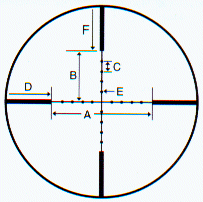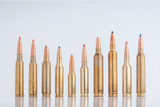How to Use Your Mil Dot Scope
How to Use Your Mil Dot Riflescope
| The Mil Dot reticle is primarily a range finding device that uses the optics of a riflescope and the known dimensions of a grid (the reticle) at unknown distances to estimate the sighted distance to a target. As a secondary function, the Mil Dots on the reticle can be set up as aiming points to compensate for holdover and wind drift. We'll address the range finding system first. Most Mil Dot scopes are set up to range find at 10X magnification. However, some scopes do it at whatever particular magnification the manufacturer has set the scope up for. Please note: Every Mil Dot scope has to be set at a specific magnification when you are using the reticle to estimate range. Be sure to set your scope for the proper magnification when ranging . |

|
These Numbers Are Accurate for Mil Dot Reticles at
100 Yards
|
1 Mil Increment
|
KISS - Keep It Simple Stupid...
The
idea is to read distance by simply looking thru your scope
while aiming. No complicated calculations... Just look and
know the distance. Explaining how it works makes it seem
more complicated than it is, so please bear with me as we go
thru the numbers.
Look at the "C" dimension in the chart and on the reticle above. 1 Mil at 100 yards is 3.6 inches or 1/10th of what it is at 1,000 yards (1/10th of 36 inches). At 200, 300, 400, etc... it is 2/10, 3/10, 4/10, etc. So, if you know the size in inches of a target, you can tell how far it is by the number of mildot increments it spans in your scope. Looking through the scope at a target 100 yards away, the distance between centers of two mil dots is 3.6 inches. If you figure the chest of a deer or antelope to be 18 inches high, at 100 yards the number of Mil dots it spans is 18 ÷ 3.6 = 5 Mil Dots. So, if you look at a deer through the scope and the chest spans 5 Mil Dots, that deer is 100 yards away. If the chest spans 2.5 Mil Dots, then the deer is 200 yards away... and so forth. See the charts at left. You should make your own chart for the dimensions of your target. This is the easiest way to estimate distances with Mil dots. |
|
Using Mil Dots as Aiming Points for Distance
Compensation -
There are many "Apps" nowadays
that you can download to your smart phone and use for
calculating hit points on your reticle. For a few dollars you can let
your app figure it all out in seconds... With extreme accuracy.
The distance between mil dots is 3.6 MOA at 10X magnification, right? That means it's 3.6 inches at 100 yards, 7.2 inches at 200 yards, and about 12 inches at 300 yards. That actually conforms pretty closely to some standard bullet trajectories ( 6.5mm BRM for example)... BUT, you can change the MOA between dots by changing the magnification (some scopes go higher than 10X). If you reduce the magnification the distance spanned between two dots increases. If you increase the magnification, the distance spanned between two dots decreases. So, the right magnification setting for each distance, you can have an exact mil dot aiming point. |
Mar 30th 2023
Recent Posts
-
6.5mm Cartridge Comparison
6.5mm Cartridge Comparison (Pictorial Overview) A Quick Look at Popular 6.5mm Rifle Cartridges Vis …Aug 11th 2025 -
Rethinking Shotgun Slug Accuracy: Why Slower Might Be Better
Last year the Browning slugs I ended up using were a departure from conventional thinking but they …Jun 12th 2025 -
The Timeless Appeal of the .308 Winchester: Why This Cartridge Endures
The .308 Winchester, introduced in 1952, has become one of the most enduring cartridges in firearms …Jul 11th 2024


